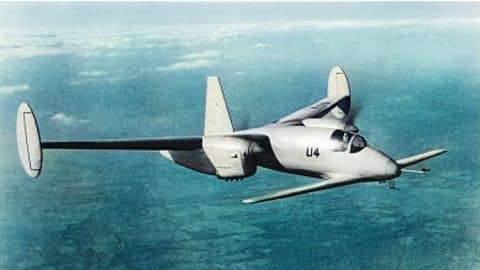
YouTube / Dark Skies
George Herbert Miles had a crazy idea that could have completely changed the fate of aviation. Back in WWII, engineers were thinking of ways to make it easier for aircraft to land on carriers.
Miles’ idea consisted of pushing the main wings to the back and mounting another set of smaller wings in the front, just above the cockpit. This, in turn, would clear the pilots’ view and would allow them to safely land even on the narrowest flight decks.
The new design sought to lessen the pilot’s problems by adopting a tandem-wing layout, which was eventually implemented in several designs of Miles Aircraft during the war. Nevertheless, their financial troubles limited their ability to build full-sized prototypes.
Instead, the company decided to build a primary technology demonstrator, which was named the M-35 Libellula after a genus of dragonflies.

All things considered, the M.35 Libellula was a relatively makeshift plane designed to test the new design – albeit a cheap and scaled-down version. Even then, the company’s test pilot refused to test the aircraft, believing that the Libellula was unsafe to fly.
Miles took over his chief test pilot’s job and tried to make the M.35 fly. Unfortunately, Miles was unable to take off with the aircraft at first, as it was discovered that its throttle needed to be closed at high speeds in order to push the plane off the ground and take flight.
Still, with the M.35 airborne and its maiden flight completed, it was a disaster. The aircraft flew erratically and uncontrollably due to the misaligned center of gravity.
After multiple changes to its design (and the prototype up and running), Miles presented his design to the British government – which quickly shut down his ideas. Refusing to give up, Miles switched gears and began to redesign the M.35 into a bomber in 1942.
It adhered to the recently published requirement of specification B-1141 and was named the M.39. The new bomber was envisioned to have a max weight of 2,000 lbs and a length of 20.3 ft.

Even so, the M.39 was plagued with issues regarding its engine and its lack of output. After several modifications, Miles presented the M.39 B, which was narrowed down to a 5/8 scale.
The single-seat prototype was powered by two 130-hp air-cooled inline engines and featured a tricycle undercarriage for landing purposes. Moreover, its already long wingspan grew to 25 ft in front and 37.5 ft at the back.
The bomber’s proposed speed was 360 mph, with 220mm cannons in the wings and provisions to carry up to 6,000 lbs of bombs in its center fuselage.

As good as it sounds, the orders for the M.39 was still canceled due to a contract issue and a shift in the RAF’s bomber demands.
The M.63, which was Miles Aircraft Company’s last proposal, was inspired by the M.35 Libellula. It was designed to have three cluster jet engines in the rear fuselage and a central dorsal fin, offering a more streamlined design with the same capabilities as the M.39 bomber.
Once more, Miles’ design would be disapproved.